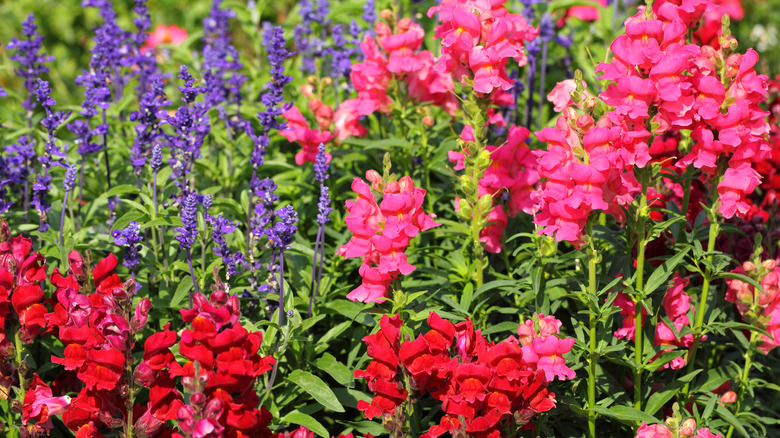Petunias are popular in many gardens due to their size, numerous flower growth, and multi-colored petals that bloom throughout the seasons. While their colorful petals stand out in every area they’re planted, they can elevate your garden even more next to flower varieties that complement their hues and size. Flowering plants like snapdragons with tall stems and various-colored petals create a flush of color when produced next to vibrant petunias.
Snapdragons grow thin and tall, and their petals bloom on the stem’s upper half, exposing their green bottoms, which gives petunias the perfect place to blossom. The varying heights allow both flower types to bloom perfectly side by side without overlapping each other. Petunias thrive in warmer climates and bloom in the spring, summer, and fall, making snapdragons the ideal companion since they require similar weather conditions that let them bloom for multiple seasons. Pairing the two in your garden and landscape will beautify its appearance.
While they don’t grow to be the same height, they both enjoy full sun and the same soil, allowing them to thrive when planted together. If you weren’t born with the greenest thumb, these two varieties are easy to grow; even the worst gardeners can handle them. While they bloom different flowers, it’ll feel like you’re growing one type due to their similar nutrient preferences.
The contrasting sizes create a fuller-looking garden

The key difference between the petunias and the snapdragons centers around their height. Snapdragons grow immensely tall, up to 36 inches, while the petunias stay closer to the ground when they bloom, growing up to 18 inches tall. Because the petunias grow shorter, they have more of an advantage in covering the snapdragon’s stems, making them look fuller. Instead of leaving pockets of space between the snapdragon’s stems, the petunias will grow between them to fill the space. As they grow, the snapdragon’s stems will hide behind the petunias. Once the petunias grow to full height, they’ll stop right before the snapdragon’s petals, adding a lush layer of flowers and beauty.
Further, the multiple colors of the petunias’ bloom will add more color to your garden and surrounding snapdragons. You can plant various hues from both flowers to have a rainbow of colors or pick two complementing tones for a contrasting look. You can plant multiple bundles of petunias and snapdragons around your home for a pop of color. For instance, grow vibrant flowers along your walkway or front side of the house for an eye-catching appeal. However, if you’re worried about too much color overwhelming your space, the petunias grow additional green stems with leaves that will help balance the many vivacious hues.
Petunia and snapdragon have similar needs
Planting companion flowers together makes the process extremely easy when they require the same nutrients. Petunias and snapdragons thrive in the same soil and climate. They both need moist, well-draining soil that’s acidic to neutral-based. It’ll allow them to grow and bloom adequately, making them the perfect pair of flowers to plant together.
While both plants can thrive in acidic soil, they prefer a more neutral soil with a pH level of 6 to 7 filled with rich nutrients. They’re not heavy feeders, so they don’t need too many nutrients or water. They’ll grow stunningly as long as their soil stays moist and covered with slight organic matter. When choosing where to plant petunias and snapdragons, always pick a sunny location. They don’t do well in shady areas, causing few petals to bloom, so opt for a full-sun area. Since they’re in bright spaces, keep an eye on their soil to ensure it stays moist. You don’t have to water them frequently when they’re established; once every other week should be enough unless you notice their soil drying out or an extreme summer heat is occurring.
On the other hand, when both of your plants are starting to grow, you can pinch off the tip of their stems to encourage good branching that will help them appear thicker and bushier. Deadheading them will improve their appearance and extend their blooming season so you can enjoy your lively flowers for many seasons.
